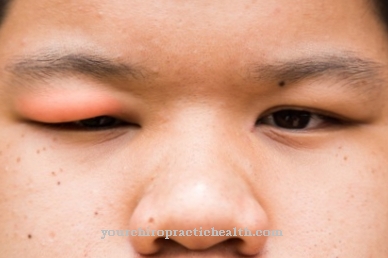Tongue coating or one coated tongue can be harmless in nature. But it can also indicate poisoning or diseases of the digestive organs. Coated tongue can also indicate poor oral care and poor nutrition. Depending on how the tongue coating looks and the circumstances under which it occurs, its cause must be clarified.
What is tongue coating?

A tongue coating is a furry or color-changed area on the surface of the tongue. This is often in the middle of the tongue.
The tongue coating is also known as the coated tongue. It consists of deposits from the lining of the tongue.
Whether the tongue coating is a symptom of an organ disease of the digestive tract, a consequence of poor oral hygiene, poisoning or unhealthy eating conditions or indicates a disease of the tongue must be determined in each individual case.
The accompanying symptoms often indicate whether the tongue coating is harmless or not.
causes
Various factors can be considered as causes of tongue coating. Some of them have already been mentioned. A harmless coating of the tongue is usually caused by food residues and germ formation on the surface of the tongue. If enough solid food is consumed, this coating on the tongue is removed automatically, otherwise this can be done with suitable means. However, if the tongue coating is an indicator of an internal disease of the digestive organs, an inflammation, an infection or even poisoning, the procedure is different.
The cause of the tongue coating can often be determined by the type and color of the coating. A white coating on the tongue can, for example, indicate mouth fungus. Febrile infections or stomach diseases also lead to a typical coating on the tongue, as do certain sexually transmitted diseases. The so-called glossitis is characterized by a smooth, red coating on the tongue with a burning sensation on the tongue. However, a coating on the tongue can also be caused by certain drugs and toxins such as lead.
Tooth and gum diseases such as periodontal disease, certain skin diseases and, above all, internal diseases that have a side effect on the oral mucosa are known to cause plaque on the tongue. The diseases lichen planus or pemphigus vulgaris can be cited as examples of such coating on the tongue. A so-called map tongue also has a patchy-looking coating on the tongue, but this is harmless. The cause of this phenomenon is not yet known.
A black coating on the tongue occurs in the so-called hairy tongue. In other cases, the tongue coating can take on the color of the food. After eating blueberries, you have a dark red coating on your tongue, like a greenish kale. A tongue coating, which is considered a precancerous condition, is known in Bowen's disease. In general, however, coating on the tongue almost never indicates a cancer of the tongue.
You can find your medication here
➔ Medicines against tartar and tooth discolorationDiseases with this symptom
- Glossitis
- gastritis
- typhus
- Liver disease
- Kidney weakness
- syphilis
- cold
- Oral thrush
- Iron deficiency anemia
- Scarlet fever
- Kawasaki syndrome
- diphtheria
- Leukoplakia
- Bowen's disease
- Nodular lichen
- Vitamin B12 deficiency
- Sjogren's syndrome
- Heavy metal poisoning
Diagnosis & course
The diagnosis and course of plaque on the tongue depend on the color, type and cause of the plaque. Some people have a light coating on their tongue for life without a specific cause being assigned. In the anamnesis, questions about possible accompanying symptoms and the duration of the tongue coating are asked in the case of conspicuous and unusual tongue coating.
If previous illnesses in the digestive tract are known, these may need to be examined more closely. Questions about diet or smoking habits can also make the diagnosis easier. If necessary, the doctor will take a tongue swab to examine the tongue coating for germs and fungi.
In some cases, a tongue coating may require a blood test, a gastroscopy, or a dental exam. In these cases it can be assumed that the tongue coating could be a symptom of a disease.
Complications
If you have a tongue coating and go to the dentist with it, you will rarely be prescribed a medication. The tongue coating can simply be scraped off the tongue or removed with a toothbrush. If the tongue coating is not treated or not removed, this usually leads to relatively poor oral hygiene.
This often manifests itself in bad breath or bad breath, which can be very repulsive for the people around you. If the tongue plaque is still not removed, inflammation can occur on the tongue, which can also be transferred to the teeth and gums. These then usually have to do with poor hygiene, so that simple cleaning and the use of a mouthwash are helpful here.
If the tongue coating is treated with medication and rinsing, it may happen that the tongue burns or hurts after the treatment. Most of the medications here are relatively aggressive and contain alcohol, so the tongue can be irritated afterwards. This irritation can spread to the neck and gums as well. However, this complication should go away as soon as treatment is finished and discontinued.
When should you go to the doctor?
Tongue coating does not always require medical clarification. Often, deposits and discoloration are triggered by certain foods, nicotine or a cold and they subside by themselves. A visit to a doctor is recommended if the tongue is unusually discolored or if the coating persists for a long period of time. If there are accompanying symptoms such as swelling or itching, a doctor should be consulted.
A dark red tongue with a thick coating indicates scarlet fever, while a white coating may have a fungal infection of the oral mucosa (oral thrush). Bluish discoloration indicates a lack of oxygen in the blood, which must be clarified immediately. If the tongue coating causes bad breath or other accompanying symptoms, the dentist must clarify the causes. The same applies if blisters or inflammation form in the mouth and especially on the tongue.
In general, the following applies: a coating on the tongue that does not cause any discomfort does not require medical clarification. However, as soon as there are complaints or there is a suspicion of a serious underlying disease, professional advice is recommended. If the tongue coating is treated early, further complications can usually be reliably avoided.
Doctors & therapists in your area
Treatment & Therapy
If the tongue coating is noticeable, therapy should be based on the cause. Oral hygiene can be improved with mouthwashes, soft toothbrushes, and special tongue scrapers.
You should also check your eating habits. Too little solid food can cause tongue coating. However, if the tongue coating is a fungal infection or candidiasis, the tongue coating can only be removed with antimycotics.
Inflammation of the gastric mucous membrane or intestinal diseases require diet or drug treatment. In the case of other causes, the coating of the tongue at the root must also be treated - i.e. by treating the underlying disease that triggered the tongue coating.
Outlook & forecast
In most cases, tongue coating is just a harmless symptom and does not require special treatment or examination by a doctor. In the worst case, however, the tongue coating can indicate poisoning. If the coating on the tongue looks unusual or is associated with pain or a burning sensation, it is advisable to consult a doctor.
When it comes to tongue coatings, the color of the coating is particularly important and can provide information about certain diseases. A white coating usually forms on the tongue after eating meals or after sleeping. This is perfectly common and can be removed while brushing your teeth. Smokers can suffer from a different colored coating, which usually disappears when the person concerned stops smoking.
Complications or other complaints can occur if the tongue coating is also associated with an unpleasant halitosis. This can impair social contacts and usually indicates a disease of the teeth or stomach. In the case of poisoning, the tongue coating takes on a different color, which depends on the type of poisoning. In such cases, a doctor or hospital must be consulted.
You can find your medication here
➔ Medicines against tartar and tooth discolorationprevention
The best prevention against plaque on the tongue is to practice good oral hygiene, eat healthy, high-fiber foods and give up smoking.
You can do that yourself
A coated tongue is quite normal. With a thin, white layer, worry is inappropriate. Only when the covering is thicker and / or has a different color is this an indication of disease.
There are good self-treatment options to get rid of the tongue coating and with it the furry mouthfeel or even bad breath. Those affected should avoid tobacco products and alcohol, prefer solid foods, avoid vitamin deficiencies and consume probiotic foods such as sauerkraut, kefir or kimchi. The covering can be rubbed off with a soft toothbrush or a scraper or using a tongue peeling instrument. Taking anti-fungal agents is also often helpful.
There are also effective home remedies. For example, after stirring a teaspoon of salt into a glass of warm water, rinse the mouth thoroughly with the well-mixed solution and gargle. Another treatment option is to dissolve half a teaspoon of baking powder in a glass of water and rinse your mouth twice a day.
Tongue plaque can also be combated by holding a tablespoon of aloe vera juice in your mouth for three minutes. Another treatment option is to liquefy a tablespoon of cold-pressed coconut oil in your mouth before brushing your teeth and to pull the enamel through your entire throat for about a quarter of an hour. Then it should be rinsed with warm water.












.jpg)



.jpg)










.jpg)
